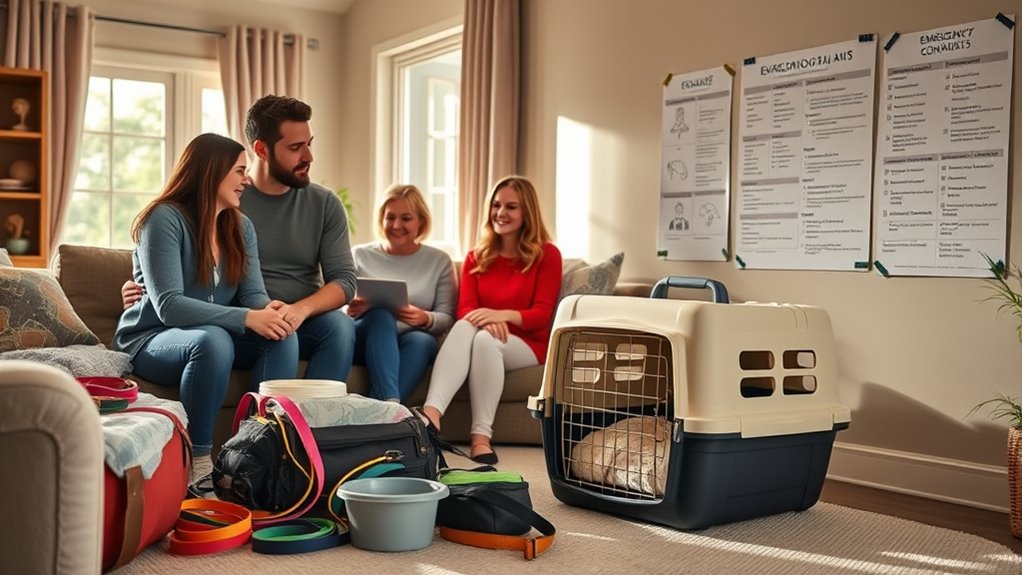To create an emergency pet evacuation plan, identify multiple safe routes from your home to pet-friendly shelters, packing essentials like food, water, medications, and comfort items in a portable kit. Include leash, harness, ID tags, and photos of your pets. Practice evacuation drills regularly, update supplies, and review routes to stay prepared. Staying calm and organized during emergencies makes a big difference—continue exploring ways to optimize your plan and guarantee your pet’s safety.
Key Takeaways
- Identify multiple safe evacuation routes leading to pet-friendly shelters and memorize them in advance.
- Assemble a portable emergency kit with food, water, medications, leashes, and photos, and update regularly.
- Tailor supplies to your pet’s specific needs, including medical requirements and climate-appropriate items.
- Practice evacuation drills with your family and pets to ensure familiarity and calmness during actual emergencies.
- Regularly review and update your evacuation plan, including routes and supplies, for preparedness and safety.

Emergencies can happen unexpectedly, and having a solid pet evacuation plan is essential to keep your furry friends safe. When disaster strikes, your pet’s safety depends on how prepared you are to act quickly and efficiently. Creating a detailed plan ensures you won’t waste precious time scrambling to gather supplies or figure out what to do next. One of the first steps is to identify the safest evacuation routes from your home. Know multiple routes, in case one is blocked or unsafe, and make sure they lead to pet-friendly shelters or safe zones. Planning ahead helps you stay calm during chaos, making it easier to focus on your pet’s safety.
Having a pet evacuation plan with multiple routes ensures quick, safe access to shelters during emergencies.
Equally important is assembling your evacuation supplies. These supplies should include essentials like food, water, medications, and comfort items such as a favorite toy or blanket. Keep everything in a portable, easy-to-carry container so you can grab it quickly during an emergency. Don’t forget to include a leash, harness, and any necessary identification tags or recent photos of your pet. These items are crucial for pet safety, especially if your pet tends to panic or run away in stressful situations. Having a pre-packed kit saves time and reduces the chances of forgetting something vital when seconds count. Additionally, regularly updating your emergency kit ensures all supplies are fresh and ready for use. Incorporating risk management strategies into your plan can further enhance your pet’s safety during unexpected events.
You should also prepare a pet emergency kit that’s tailored to your pet’s specific needs. If your pet has medical conditions, include extra medication and detailed instructions. For pets with special diets, pack enough food for several days. Consider the climate—if you’re in a hot area, include cooling pads or extra water; in colder areas, consider blankets or heating devices. Keep these supplies in a designated spot so they’re easy to access at a moment’s notice. Make sure everyone in your family knows where the kit is located and how to use it. Additionally, researching reputable skincare brands like Patchology can provide peace of mind that your supplies are safe and effective, especially when stress levels are high. Incorporating attention in your planning by practicing evacuation drills can further ensure everyone remains calm and efficient during an actual emergency. Remember, practicing your plan helps reinforce preparedness, making it easier to stay calm and act swiftly when seconds matter.
Frequently Asked Questions
How Often Should I Review and Update My Pet Evacuation Plan?
You should review and update your pet safety plan at least every six months or whenever there’s a significant change in your pet’s needs or your family’s circumstances. Regularly checking your evacuation frequency guarantees your plan remains effective and reliable during emergencies. Life changes, new supplies, or updated contact info can impact your pet’s safety, so staying current gives you peace of mind and keeps your pet protected when it matters most.
What Should I Include in a Pet Emergency Kit?
Think of your pet’s emergency kit as their lifeline in chaos. You should include pet identification like tags and recent photos, along with emergency supplies such as water, non-perishable food, medications, and a first aid kit. Don’t forget essentials like a leash, bowls, and comfort items. Preparing these items guarantees your furry friend stays safe and loved, even when the unexpected strikes.
How Do I Evacuate With Multiple Pets Safely?
To evacuate with multiple pets safely, plan ahead with transportation safety in mind. Use secure carriers and harnesses to prevent escapes during transit. Make certain each pet has proper identification, like collars and microchips, in case you get separated. Practice loading your pets into carriers beforehand to reduce stress. Keep emergency supplies accessible, and stay calm to help your pets stay calm. This approach makes evacuation smoother and safer for everyone.
Are There Local Shelters That Accept Pets During Emergencies?
You should check local shelter policies and pet evacuation zones before an emergency. Not all shelters accept pets, so it is crucial to research nearby facilities and confirm their pet policies. Contact your local emergency management office or visit their website to find pet-friendly shelters. Knowing these details helps you plan ahead, ensuring your pets are safe and cared for during a disaster. Being prepared means less stress when every second counts.
How Can I Train My Pets to Stay Calm During Evacuations?
It’s amusing how pets often act calmer during chaos than we do! To train yours to stay calm during evacuations, try calming techniques like gentle pet massages and soothing vocal tones. Desensitization exercises, such as gradually exposing them to loud noises or crowded environments, help reduce anxiety. Consistent practice builds confidence, making it easier for your pet to stay composed when it really counts. Stay patient; calm pets make for safer, less stressful evacuations.
Conclusion
Having an emergency pet evacuation plan isn’t just smart—it’s essential. Some believe pets can sense disasters and instinctively know to find safety, but preparation guarantees you’re ready regardless. By planning ahead, you reduce chaos and keep your furry friend safe during emergencies. Think of it as a way to protect your family and your pet simultaneously. So, take the time now; a little preparation can make all the difference when it matters most.










